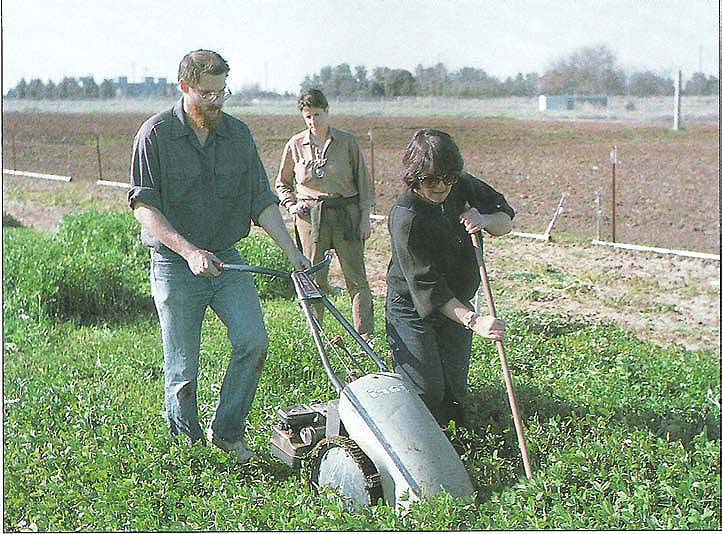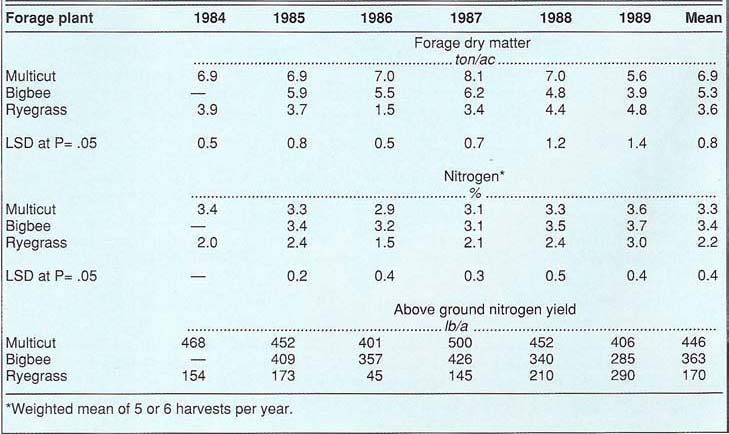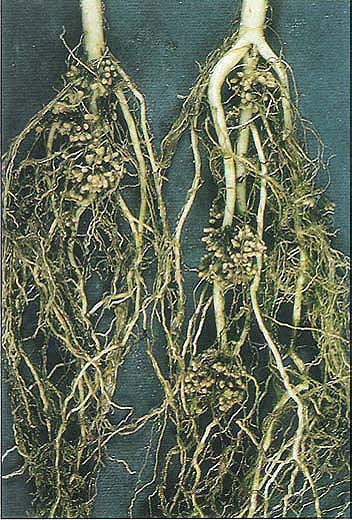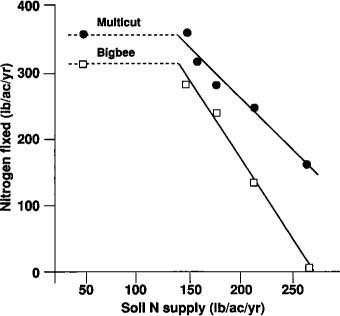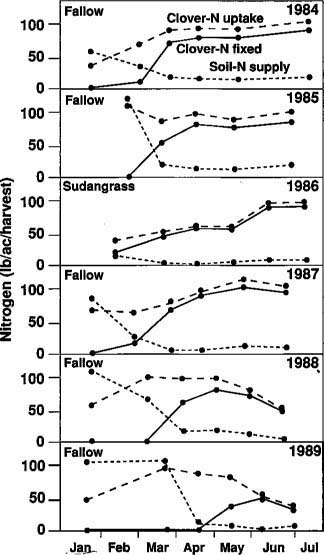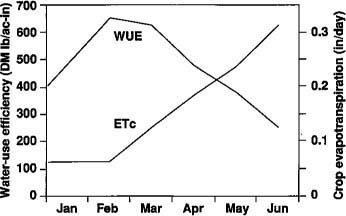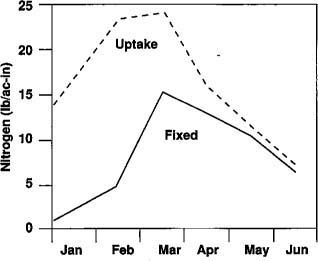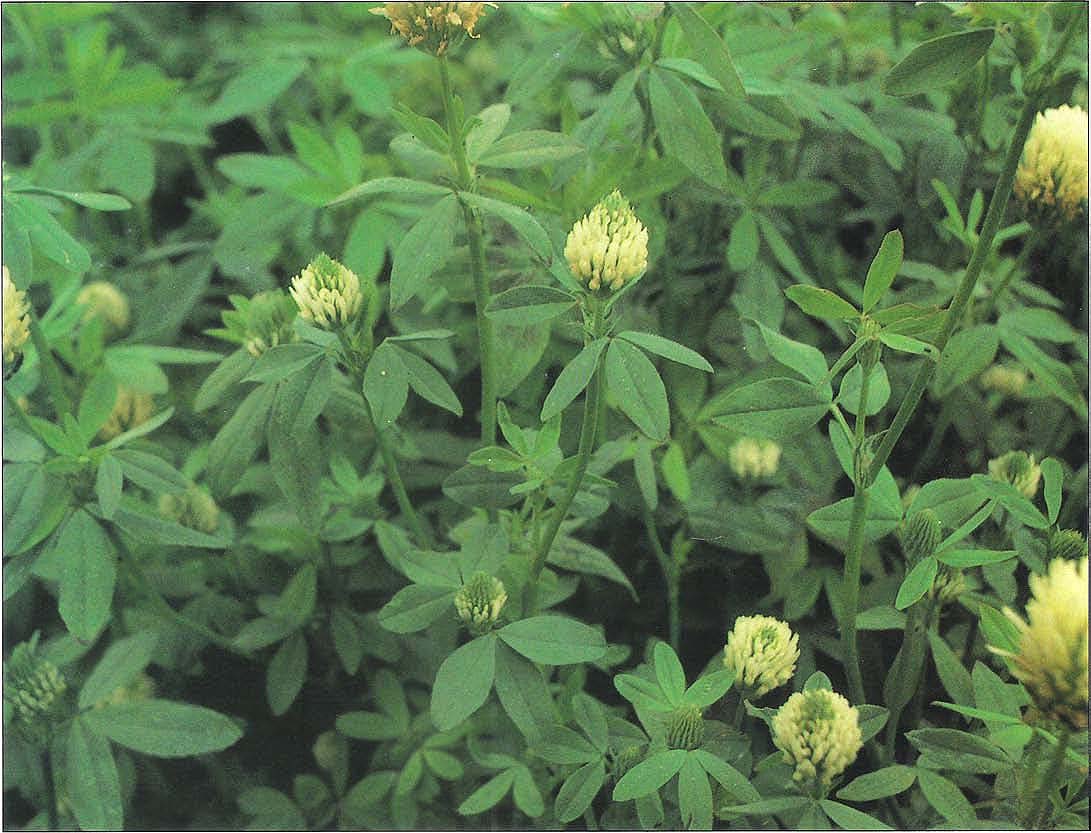All Issues
Water-efficient clover fixes soil nitrogen, provides winter forage crop
Publication Information
California Agriculture 45(4):30-32.
Published July 01, 1991
PDF | Citation | Permissions
Abstract
The high yield and excellent protein content of ‘Multicut’ berseem clover make it a useful winter forage and cover crop option on Valley and foothill land where supplemental irrigation is available. This variety is a winter-and-spring annual that produces five or six cuttings from January to June if planted in October. Timing of the winter harvests is weather-dependent. Water use by berseem is about the same as for annual ryegrass pasture or oats grown for hay. Variety and nitrogen-fixation trials have been conducted at Davis since 1983. The help of Richard Caldwell, Lawrence Larsen, R. S. Loomis, Helena Marques, Dan Pantone, and Richard Snyder is gratefully acknowledged. Cultural practice recommendations for berseem clover were reported in California Agriculture in September 1987. Some of the nitrogen fixation data were published previously in the Journal of Agronomy and Crop Science 264:202–207, 2990.
Full text
Nitrogen fixation potential and estimated water use efficiency are reported here for two berseem varieties in studies conducted over six growing seasons on a fertile Yolo loam soil. Several berseem clovers (Trifolium alexandrinum) and annual ryegrass (Lolium multiflorum) were planted in early October each year at seeding rates of 18 to 45 pounds per acre (lb/ac) on fallow ground (except after sudangrass for 1986 harvests). The clover seed was inoculated with appropriate rhizobia. Sprinkler irrigation was used for establishment and again in the spring when rainfall became inadequate. Plot size averaged 7 x 20 feet, and the trials were laid out in randomized blocks with four replications. No fertilizer or pesticide was used on the plots. Five or six cuttings were made per growing sea-son from January or February to June or July, leaving adequate borders, which were removed from the field along with the cuttings.
Soil nitrogen supply was estimated for each harvest interval by measuring the nitrogen taken up by the harvested ryegrass. This estimate of soil nitrogen supply was subtracted from the nitrogen accumulated in the clover forage to give us the amount of nitrogen fixed according to the “difference” method (root nitrogen was not measured). The berseem clover varieties ‘Multicut’, recently released by the UC Agricultural Experiment Station, and ‘Bigbee’, a Mississippi release, were selected for inclusion in this analysis because of their contrasting behavior in forage production and nitrogen fixation. Canopy height at harvest is usually about 20 inches for Multicut and 14 inches for Bigbee. Flowering begins in late May for Multicut and middle of May for Bigbee.
Nitrogen fixation
The mean annual dry forage produced was 6.9, 5.3, and 3.6 tons/ac for Multicut, Bigbee and ryegrass, respectively (table 1). Nitrogen in the forage averaged 3.3% in the clovers and 2.2% in the ryegrass. Above-ground nitrogen yield averaged 450 and 360 lb/ac for the two clovers and 170 lb/ac for the ryegrass, with mean annual differences (legume - nonlegume) of 280 lb/ac for Multicut and 190 lb/ac for Bigbee attributable to their nitrogen-fixing ability.
Closeup of clover roots shows nitrogen fixing nodules; their relatively large size indicates effectiveness. When opened, such nodules are red due to hemoglobin content.
The amount of nitrogen fixed per year by clover increased with decreasing soil nitrogen supply as estimated by the seasonal nitrogen accumulation in the ryegrass (fig. 1 reading left to right). However, as the total-season nitrogen supply fell below about 150 lb/ac, estimates of total-season nitrogen fixation changed very little. In these trials, soil nitrogen supply was greatest in 1988 and 1989 after successive drought years allowed some carryover of the previous seasons accumulation. The observation that this soil supplies abundant nitrogen after lying fallow was confirmed in prior studies at this site.
The nitrogen fixation responses of the two clover varieties are similar. The sloping lines in figure 1 show that when soil nitrogen exceeds 150 lb/ac it limits fixation at this site. The difference between the two clover varieties in their parallel behavior is probably due to genetic factors affecting yield and nitrogen fixation.
Fig. 1. Nitrogen fixed per growing season by two berseem clover varieties as a function of soil nitrogen supply.
The progress of nitrogen fixation by Multicut over the individual growing seasons shows that little nitrogen was fixed before March 1 (fig. 2), even though considerable nitrogen uptake and forage production occurred. The maximum rate of nitrogen fixation was usually reached in April and May, during the fourth or fifth harvest interval. The seasonal pattern of nitrogen fixation was inversely related to the soil nitrogen supply. In all years, regardless of the early season soil nitrogen supply, soil nitrogen availability was minimal from April to the last cutting in June or July.
Water-use efficiency
Water-use efficiency was calculated from dry matter yield and estimated cumulative water use (evapotranspiration). Daily reference evapotranspiration values were obtained from the Department of Water Resources via the California Irrigation Management Information System (CIMIS) computer network and based on data collected one mile from our experimental site. These values were multiplied by daily crop coefficients and then averaged by calendar date for the six growing seasons to estimate crop evapotranspiration or water use. (The crop coefficient is a factor that takes into account the difference in evapotranspiration between the crop in question and the reference evapotranspiration.) Crop coefficient values (0.4 to 1.0) were based on typical soil moisture conditions during autumn (October 10 to December 21) for berseem clover establishment, and on coefficients (0.4 to 1.2) used for alfalfa during the harvesting cycles (UC DANR Leaflet 21427). Daily rates for clover dry matter production were calculated for each harvest interval in the six growing seasons and averaged by calendar date.
The estimated water-use efficiency values ranged from about 400 to 640 pounds of dry matter per acre-inch (lb/ac-in) water used in the first four cutting intervals and dropped to an average of 300 lb/ac-in. for the last two harvests as evaporative demand increased in May and June (fig. 3). These values may be compared to season-long mean values of irrigated alfalfa under various climatic regimes in the U.S.: 390 lb/ac-in from Idaho, 410 lb/ac-in from Texas, 520 lb/ac-in from Utah, and 610 lb/ ac-in from California, according to other published studies. Unlike alfalfa, berseem clover has the water-use advantage of being produced primarily during the rainy season before crop evapotranspiration reaches an early summer peak. Alfalfa production occurs mostly during the hot and dry, high-water-demand period, except for winter production in the southern low desert valleys.
Fig. 2. Seasonal progress of nitrogen fixation and nitrogen uptake by Multicut berseem clover and soil-nitrogen supply (uptake) by annual ryegrass during six growing seasons at Davis. The data points represent results of individual harvests. “Fallow” and “sudangrass” indicate the treatment the previous growing season.
Fig. 3. Estimated water-use efficiency of Multicut berseem clover (WUE) and crop evapotranspiration (ETc) based on daily means for six growing seasons at Davis.
Fig. 4. Six-year means for the seasonal progression for estimated water-use efficiency of nitrogen fixation and nitrogen uptake by Multicut berseem clover at Davis.
Berseem clover in flower: this high-yielding, water-efficient crop provides forage during winter months when alfalfa is mostly dormant in Northern California.
The 6-year means for the seasonal progression of nitrogen fixation and nitrogen uptake per unit of water used by berseem clover can be seen in figure 4. Nitrogen fixation rose sharply to 15 lb nitrogen/ac-in by March and dropped to 6 lb nitrogen/ ac-in by June. The nitrogen accumulation peaked at 24 lb nitrogen/ac-in by March, and then dropped rapidly. Early in the season, the two low values for nitrogen fixation per unit of water used resulted from the primary dependence of the clover on soil nitrogen until the soil nitrogen supply was depleted in March. Then substantial nitrogen fixation began.
Conclusions
The nitrogen fixation relationships observed show that an abundant soil nitrogen supply restricted the annual fixation by clover, but that moderate amounts of soil nitrogen (up to 150 lb/ac) did not limit annual fixation in this productive field situation. The seeming contradiction of the principle that fixation occurs only when the nitrogen supply is inadequate is understandable from the within-season dynamics of the nitrogen processes seen in these experiments. Clover made heavy use of the soil nitrogen supply in the early part of the growing season, but provided very little nitrogen fixation. After depleting the available soil nitrogen, clover changed abruptly into the fixation mode and fixed nitrogen rapidly until normal life-cycle maturation resulted in seed production and senescence.
The water-use efficiency values that we estimated for berseem clover are similar to those for irrigated alfalfa measured by other researchers. Our highest water-use efficiency values for berseem occurred for harvests in January to April. Alfalfa, a perennial, does not need seeding every growing season like berseem; however, berseem clover provides water-efficient forage of high quality during the winter months when alfalfa is mostly dormant in Northern California.



